|
|
This is an old revision of the document!
Table of Contents
Parabolic SAR
Introduction
Developed by Welles Wilder, the Parabolic SAR refers to a price-and-time-based trading system. Wilder called this the “Parabolic Time/Price System.” SAR stands for “stop and reverse,” which is the actual indicator used in the system. SAR trails price as the trend extends over time. The indicator is below prices as they're rising and above prices as they're falling. In this regard, the indicator stops and reverses when the price trend reverses and breaks above or below the indicator.
Wilder introduced the Parabolic Time/Price System in his 1978 book New Concepts in Technical Trading Systems. This book also includes RSI, Average True Range (ATR), and the Directional Movement Concept (ADX). Despite being developed before the computer age, Wilder's indicators have stood the test of time and remain extremely popular.
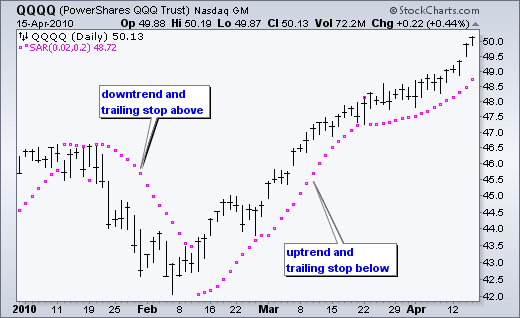
Calculation
Calculation of SAR is complex with if/then variables that make it difficult to put in a spreadsheet. These examples will provide a general idea of how SAR is calculated. Because the formulas for rising and falling SAR are different, it is easier to divide the calculation into two parts. The first calculation covers rising SAR and the second covers falling SAR.
Rising SAR ---------- Prior SAR: The SAR value for the previous period. Extreme Point (EP): The highest high of the current uptrend. Acceleration Factor (AF): Starting at .02, AF increases by .02 each time the extreme point makes a new high. AF can reach a maximum of .20, no matter how long the uptrend extends. Current SAR = Prior SAR + Prior AF(Prior EP - Prior SAR) 13-Apr-10 SAR = 48.28 = 48.13 + .14(49.20 - 48.13) The Acceleration Factor is multiplied by the difference between the Extreme Point and the prior period's SAR. This is then added to the prior period's SAR. Note however that SAR can never be above the prior two periods' lows. Should SAR be above one of those lows, use the lowest of the two for SAR.
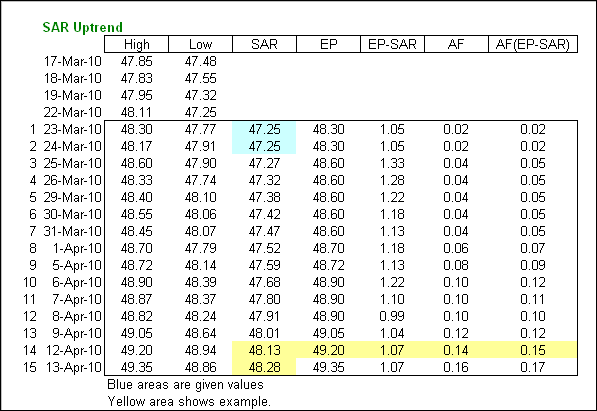
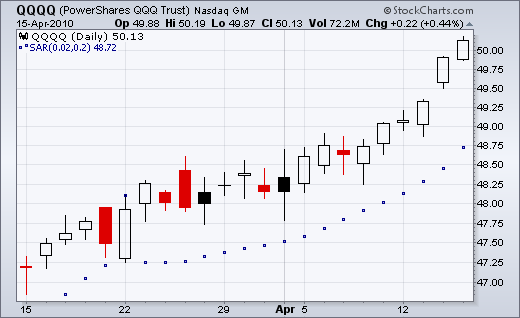
Falling SAR ----------- Prior SAR: The SAR value for the previous period. Extreme Point (EP): The lowest low of the current downtrend. Acceleration Factor (AF): Starting at .02, AF increases by .02 each time the extreme point makes a new low. AF can reach a maximum of .20, no matter how long the downtrend extends. Current SAR = Prior SAR - Prior AF(Prior SAR - Prior EP) 9-Feb-10 SAR = 43.56 = 43.84 - .16(43.84 - 42.07) The Acceleration Factor is multiplied by the difference between the Prior period's SAR and the Extreme Point. This is then subtracted from the prior period's SAR. Note that SAR can never be below the prior two periods' highs. Should SAR be below one of those highs, use the highest of the two for SAR.
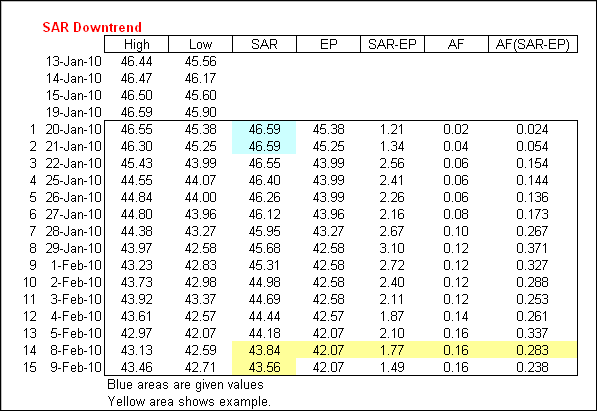
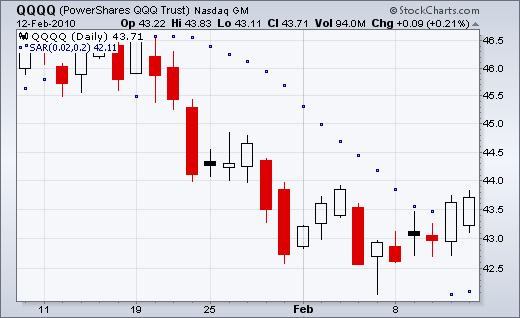
Interpretation
SAR follows price and can be considered a trend following indicator. Once a downtrend reverses and starts up, SAR follows prices like a trailing stop. The stop continuously rises as long as the uptrend remains in place. In other words, SAR never decreases in an uptrend and continuously protects profits as prices advance. The indicator acts as a guard against the propensity to lower a stop-loss. Once price stops rising and reverses below SAR, a downtrend starts, with SAR above the price. SAR follows prices lower like a trailing stop. The stop continuously falls as long as the downtrend extends. Because SAR never rises in a downtrend, it continuously protects profits on short positions.
Step Increments
As shown in the spreadsheet example, the Step, also referred to as the Acceleration Factor (AF), is a multiplier that influences the rate-of-change in SAR. SharpCharts users can set the Step and the Maximum Step. The Step gradually increases as the trend extends until it reaches the maximum set by the user. The Step dictates the sensitivity of the SAR indicator.
SAR sensitivity can be decreased by decreasing the Step. A lower step moves SAR further from price, which makes a reversal less likely. Similarly, SAR sensitivity can be increased by increasing the step. A higher step moves SAR closer to the price action, which makes a reversal more likely. The indicator will reverse too often if the step is set too high. This will produce whipsaws and fail to capture the trend.
Chart 6 shows IBM with SAR (.01, .20). The step is .01 and the Maximum Step is .20. Chart 7 shows IBM with a higher Step (.03). SAR is more sensitive in chart 7 because there are more reversals. This is because the Step is higher in chart 7 (.03) than chart 6 (.01).
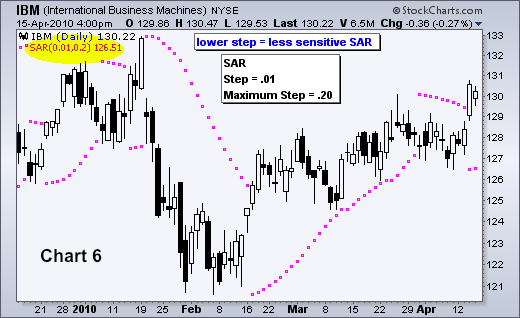
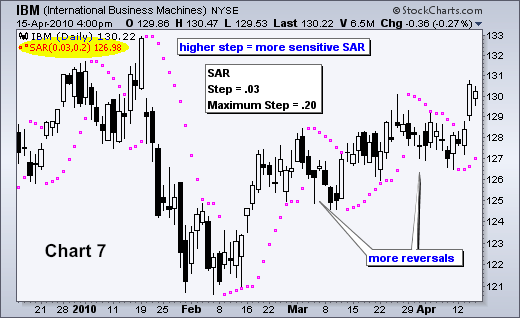
Maximum Step
The sensitivity of the indicator can also be adjusted using the Maximum Step. While the Maximum Step can influence sensitivity, the Step carries more weight because it sets the incremental rate-of-increase as the trend develops. Also, note that increasing the Step ensures that the Maximum Step will be hit quicker when a trend develops. Chart 8 shows Best Buy (BBY) with a Maximum Step (.10), which is lower than the default setting (.20). This lower Maximum Step decreases the sensitivity of the indicator and produces fewer reversals. Notice how this setting caught a two-month downtrend and a subsequent two-month uptrend. Chart 9 shows BBY with a higher Maximum Step (.20). This higher reading produced extra reversals in early February and early April.
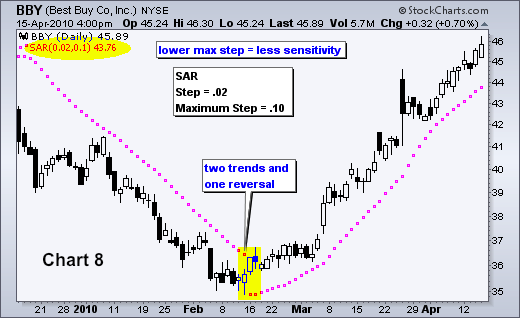
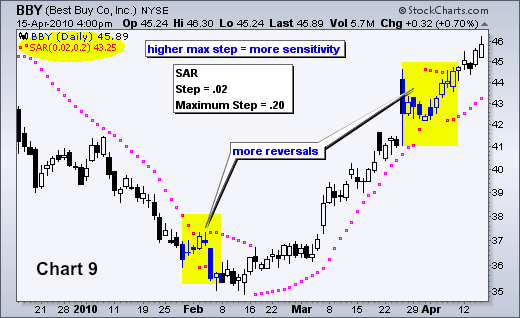
Conclusion
The Parabolic SAR works best with trending securities, which occur roughly 30% of the time according to Wilder's estimates. This means the indicator will be prone to whipsaws over 50% of the time or when a security is not trending. After all, SAR is designed to catch the trend and follow it like a trailing stop. As with most indicators, the signal quality depends on the settings and the characteristics of the underlying security. The right settings combined with decent trends can produce a great trading system. The wrong settings will result in whipsaws, losses, and frustration. There is no golden rule or one-size-fits-all setting. Each security should be evaluated based on its own characteristics. Parabolic SAR should also be used in conjunction with other indicators and technical analysis techniques. For example, Wilder's Average Directional Index can be used to estimate the strength of the trend before considering signals.
Using with SharpCharts
The Parabolic SAR can be found as an Overlay in SharpCharts. The default parameters are .02 for the Step and .20 for the Maximum Step. As shown above, these can be changed to suit the characteristics of an individual security. The example below shows the indicator in pink with prices in black/white and the chart grid removed. This contrast makes it easier to compare the indicator with the price action of the underlying security. Click here for a live example of Parabolic SAR.
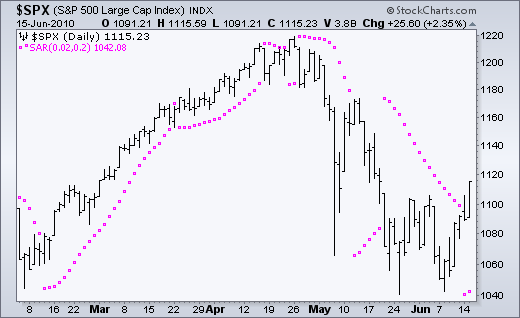
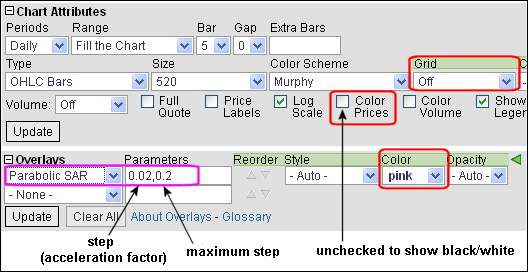
Suggested Scans
Break Above Falling SAR
This scan starts with stocks that have an average price of $10 or greater over the last three months and average volume greater than 40,000. The scan then filters for stocks that have a bullish SAR reversal (Parabolic SAR (.01,.20)). This scan is just meant as a starter for further refinement.
[type = stock] AND [country = US] AND [Daily SMA(20,Daily Volume) > 40000] AND [Daily SMA(60,Daily Close) > 10] AND [Yesterday's Daily High < Yesterday's Daily Parabolic SAR(0.01,0.2)] AND [Daily High > Daily Parabolic SAR(0.01,0.2)]
Break Below Rising SAR
This scan starts with stocks that have an average price of $10 or greater over the last three months and average volume greater than 40,000. The scan then filters for stocks that have a bearish SAR reversal (Parabolic SAR (.01,.20)). This scan is just meant as a starter for further refinement.
[type = stock] AND [country = US] AND [Daily SMA(20,Daily Volume) > 40000] AND [Daily SMA(60,Daily Close) > 10] AND [Yesterday's Daily Low > Yesterday's Daily Parabolic SAR(0.01,0.2)] AND [Daily Low < Daily Parabolic SAR(0.01,0.2)]
For more details on the syntax to use for Parabolic SAR scans, please see our Scanning Indicator Reference in the Support Center.
Additional Resources
Stocks & Commodities Magazine Articles
The Parabolic Trading System by Thom Hartle
Oct 1993
Parabolics by John Sweeney
Jun 1997
